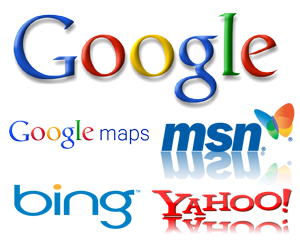Search Engine Optimization – What is it?
[dropcap]S[/dropcap]earch Engine Optimization (SEO) is a method used by website designers and programmers to increase your website’s ranking in search engines, such as Google, MSN, Bing, Yahoo and so on. Most SEOers use a variety of techniques while performing search engine optimization on your website. Some of the commonly known techniques include content writing and optimization, (reciprocal) link building, business directory submissions, and local search engine map listing optimization. Also, the structure or platform of your website may need to be optimized to allow for better SEO. For more information on these different techniques and structural soundness, see the sections entitled “Search Engine Optimization – Different Techniques” and “A Structurally Sound Website is Needed for SEO“.
A Structurally Sound Website is Mandatory for Effective SEO
 Having a structurally sound website is necessary for better SEO results. Think of your website like you would your desk; how much can you really get done without having it organized? While building your website, it is important to build it in a way that will allow search engines to easily visit, and rank, each of your pages. Creating sitemap.xml and robot.txt files are a quick way to do this. These files will ensure that search engines can easily navigate through your site and find the data they need. Internal text page links are also important. Structurally sound websites should exhibit all of the features listed below:
Having a structurally sound website is necessary for better SEO results. Think of your website like you would your desk; how much can you really get done without having it organized? While building your website, it is important to build it in a way that will allow search engines to easily visit, and rank, each of your pages. Creating sitemap.xml and robot.txt files are a quick way to do this. These files will ensure that search engines can easily navigate through your site and find the data they need. Internal text page links are also important. Structurally sound websites should exhibit all of the features listed below:
Relevant, Properly Formatted SEO Page Titles Say it All
Page titles should be short (70 characters or less), concise and relevant. Just like an “intro paragraph” from grammar school, your page titles should be relevant and quickly to the point. Remember that when your website is displayed in search engine results, the main display item is the Title. This is commonly followed by the META description and your webpage URL. Do not overdo your titles. Using sentences strung together with your desired keywords won’t fool a search engine. Titles should be written to accurately describe the content found throughout each specific page. Your page titles should not necessarily be the same for the entire site.
According to SixRevisions.com, below are the top 5 common mistakes made when creating page titles for SEO sites:
“1. Not Having a Title
2. Page Titles That Are Too Short or Too Long
3. Keyword Cannibalization
4. Using the Company/Site Name in All Web Pages
5. Duplicate Web Page Titles”
Read the full article here for more information on each of these 5 common mistakes while titling pages.
Navigation Bar(s) – Easy to Navigate
Finding the way through your site should be one or two clicks away. Most people (and search engines) don’t like confusing or overly animated site navigation. Be sure to have plain text links to all of your pages, or at least your main pages. These main pages should include text links to all sub-pages. Remember, easy navigation is important! Try not to be redundant with links, though. Multiple links to the duplicate pages can count against you while search engines calculate your linking percentages. A main navigation, footer navigation to main pages and a sitemap page (or sitemap.xml) should be plenty. Make sure users of your website are able to see all of the hard work you have put into your website!
Organized Content for SEO – Headings, Paragraphs, and Styles
For SEO, each of your web pages should follow standard organization when it comes to your content. Proper use of headings (H1, H2, H3, etc.) and paragraphs is a must. Headings should briefly summarize the information contained in the paragraph(s) below. Headings should not be full sentences. Short, concise headings will easily draw a users attention. They will also provide information to search engines concerning page relevancy for its users’ keyword searches. You should also never use excessive breaks or open/close paragraphs for styling. Styles should be defined in your stylesheet(s).css and the appropriate styles assigned to each heading or paragraph.
META Tags – Precursors for Search Engines
As previously mentioned, META tags are important content that most users will never see. Hidden in the “head” area of your web page, the META tags include information about keywords, descriptions, and authors. Additional information includes instructions regarding suggested indexing options, FOLLOWing (or NOFOLLOWing) links contained within the page, and other related options. See this article about FOLLOW and NOFOLLOW links. For the most part, be sure that every page has a META description tag. As stated above, this META description is the content used to describe your web page in a search engine’s results page. Also, be aware that changing these settings incorrectly can adversely effect the rankings of your pages, and so these types of changes should be handled by a responsible SEO.
SEO Friendly ALTs and/or Titles for Links and Images
Alt and Title attributes for links and images. As smart as search engines are, they are unable to necessarily “view” an image and understand what it contains. For this reason, there are tags that can be used to instruct a search engine of the content contained within the image. These tags, along with titles of links, can be very helpful when it comes to SEO. Make sure not to leave these items out.
Here is an excerpt from an excellent article about Alts and Titles:
FEATURED EXCERPT:
“So from my testing I’ve determined that a title attribute is meant to provide tool-tips to the user for user experience, whereas the alt attribute is helpful in terms of providing alternative information to the user when their browser cannot display an image or input element and helping to increase the SEO of a website. My recommendation is to pay close attention to when, where and how you are using your alt attributes. If they help with SEO, then you should pay close attention to what you are adding.
When adding images always be sure to add an alt attribute to the code of each image. If you do not have one, then just specify a blank one, such as alt=””. Also, be sure to add alternative text that is relevant to that image, the content on that page and be sure not to specify an alt attribute greater than 100 characters in length, as this may be perceived as spamming.
I hope you find my brief overview on the topic of, “Do Alt and Title Attributes Help with SEO?” to be beneficial for you and your business. I’m sure one could dive deep into this topic, spending weeks determining the differences between how Google, Yahoo! and the other major search engines handle title and alt attributes with regards to SEO for a website.”
Inbound and Outbound Links
Links are very important for calculating Google’s PageRank. For newly developed sites, inbound links are essential. Returning to content, having a large amount of relevant content and outbound links to other highly relevant sites will help. For example, links to non-competitor pages (for search engine optimization) like “WikiPedia’s Search Engine Optimization” wiki, SEOmoz’s “Beginner’s Guide to SEO” and Google’s “Search Engine Optimization for Webmaster Tools” will help create outbound links to “authoritative” content. Reciprocal linking is also very important; check out this Link Directory for an example of a Web Directory, and here is a Blogs Directory.
